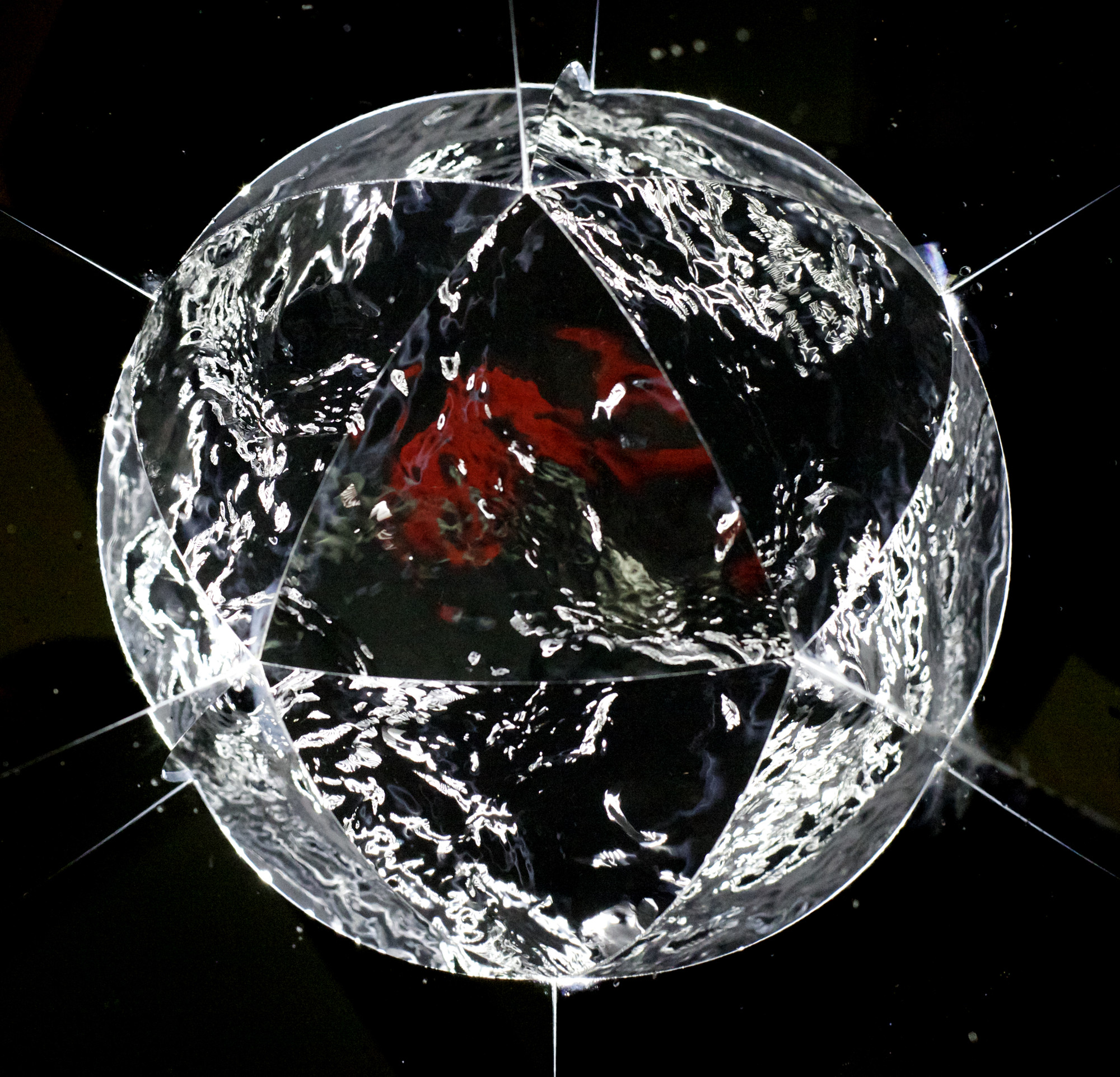
I built this piece for Art Hack Day this weekend at 319 Scholes.
I have been doing work with mirrors for about a year. This “analog” work is inspired by and co-evolves with my digital video work (e.g. interactive video installations with cameras and projectors/screens). I think of interactive art work as pieces which take information from the environment, process or transform that information, and then output information back to the environment (e.g. on a projector, screen, speaker, etc). The advantage of using mirrors for this work versus a camera, computer, and screen is that less information is lost in the transformation. Mirrors have maximum resolution, minimum latency, and critically preserve the intensity and angle of light. That is, when you see an object in a mirror it still looks 3D and real–like you could grab it–unlike seeing a picture of an object on a screen.
I’ve had the idea for Sphere of Water for several months. I had built computer visualizations and janky prototypes. I don’t consider the Art Hack Day version finished, but I do consider it above the critical threshold where the viewer sees it–on first impression–as the intended representation. As I was building my first prototype on Friday out of mylar, people would come by to see it and they’d stare for a few moments and then say “Oh, I see the sphere”. That is, they initially saw the materials and had to look for the intended representation. But by the end of the hackathon I had gotten above the threshold where this is reversed–where people initially see the sphere and then have to examine the contraption to see how it “actually” works.
To do this–to create a successful illusion–you need to take into account the cues that people use to make sense of the world. In this case, the tapered kaleidoscope creates the 3D geometry (the tapering bends the kaleidoscopic infinite plane into a sphere). The water is moved with a pump and lit in such a way that only the surface is visible, so that people don’t look into the water. Next a mirror at 45 degrees is placed above the kaleidoscope to reorient gravity. The cue that gravity points down is very strong in people. For the Sphere of Water, due to this 45 degree mirror, gravity points forward. Finally, the illusion only works from certain angles so I obscured much of the contraption and cut a “window” through which to see it. I also installed the piece in a small dark room (janitor’s closet) at eye level to make these concessions feel natural.
The result is that these perceptual cues cause people to see something which collides forcefully with their model of the world. To reconcile this collision, viewers need to consciously or subconsciously reexamine their system of perception and/or their model of the world. Rebuilding our view of the world is the purpose of art, as far as I can tell.
The people and resources that 319 Scholes brought in for this hackathon were very helpful for production. I made several trips to chinatown for materials–mylar, front-surface acrylic mirrors, and water-proof LED ribbon (it’s so helpful that these materials can still be acquired a few subway stops away, without having to buy online). I used the laser cutter provided by Fabricator’s Guild to cut the mirror to the exact angles that I needed, and to cut the foamcore supports. Many of the materials were shared and repurposed by other participants in the hackathon. Nova Jiang and Olov Sundstrom used my leftover mylar to create a beautiful light box to display their 3D fabricated sculptures.
There was lots of cross collaboration on projects. Also over the weekend I built Haiku Wifi with Jonathan Dahan. I helped various people with coding their projects, and also received advice about materials and mechanics on Sphere of Water–what glue do I use to waterproof the lights, how do I keep the pump from flipping over, etc. Sofy Yuditskaya, art materials genius, was especially helpful.
The mix of backgrounds present in this community are extremely powerful. I come from a more technical background (math and computer science), so I’ve learned so much from people with more art, design, and architecture backgrounds about how to effectively deliver a concept to viewers. When you’re dealing with lots of technicalities you sometimes miss the human factors like scale, putting things at eye level, understanding how people flow through a room, and other details which really make a piece work. This combination of disciplines along with a powerful drive to create new realities is the most exciting thing happening in New York City!